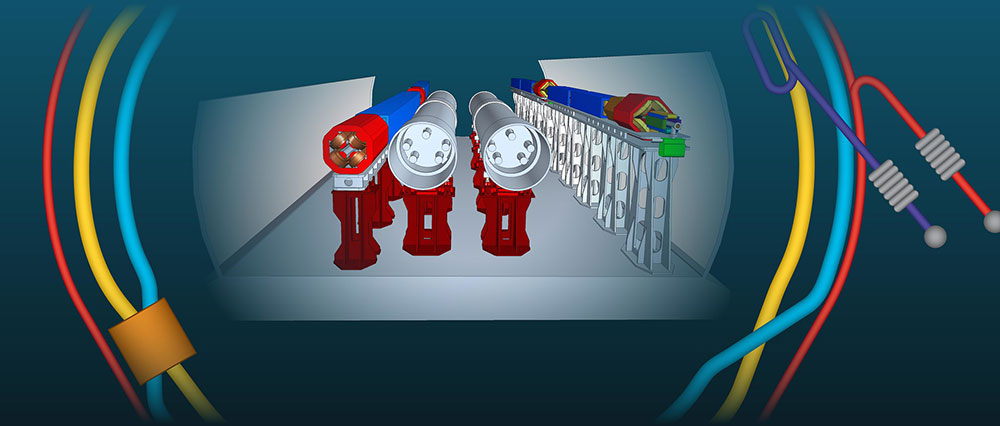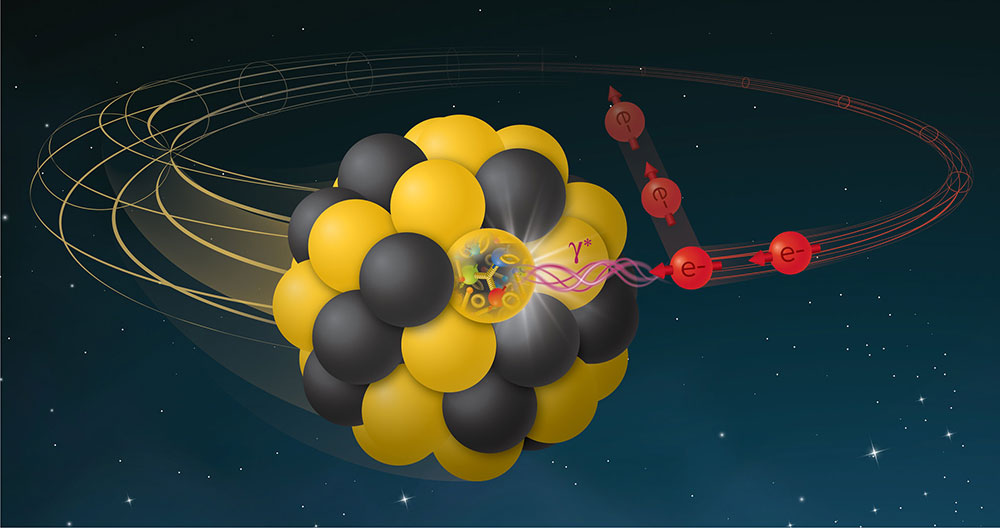Electron-Ion Collider Project Gears up for Next Steps
With a buoy of Inflation Reduction Act funding, Jefferson Lab is helping design and build a first-of-its-kind collider in New York to learn more about matter at the smallest scale
October 26, 2023
By Chris Patrick
 enlarge
enlarge
The Electron-Ion Collider (EIC) is a complex particle accelerator with many components. The cutaway schematic shows the view inside the tunnel and includes the new electron storage ring (left), the twin ion accelerator rings of the existing Relativistic Heavy Ion Collider (RHIC, center) at Brookhaven Lab, and the electron accelerator ring (right). One of the RHIC ion-storage rings will be reused for storing ions for EIC collisions with electrons.
The following feature article was originally posted by the U.S. Department of Energy’s Thomas Jefferson National Accelerator Facility (Jefferson Lab). Jefferson Lab and DOE’s Brookhaven National Laboratory are partners in building the Electron-Ion Collider (EIC). For more information about this collider, which will be located at Brookhaven, contact: Karen McNulty Walsh, kmcnulty@bnl.gov, (631) 344-8350.
NEWPORT NEWS, VA – There’s a new particle collider on the horizon that will allow nuclear physicists to better understand matter at its most fundamental level. The U.S. Department of Energy’s Thomas Jefferson National Accelerator Facility is contributing its expertise to help make this new collider, the Electron-Ion Collider (EIC), a reality. The project has been aided by $33.06 million in Inflation Reduction Act (IRA) funding that Jefferson Lab received to help the project move on more quickly.
The nucleus of an atom of ordinary matter is made up of protons and neutrons, which are in turn made up of smaller particles called quarks. More than 1,800 nuclear physicists worldwide conduct research at Jefferson Lab to learn more about these quarks. They carry out their research with the Continuous Electron Beam Accelerator Facility (CEBAF), a DOE Office of Science user facility.
However, if you add up the mass of the three quarks inside of a proton or neutron, it doesn’t equal the total mass of the particle. Nuclear physicists believe that’s because mass, spin and other properties of protons and neutrons also come from the interactions of their quarks with so-called gluons. Gluons are the particles that carry the strong force, binding quarks together into the protons, neutrons, and other particles inside matter that we can study.
While CEBAF provides insight into the quark structure of matter, nuclear physicists believe that the EIC, to be constructed at DOE’s Brookhaven National Laboratory in New York, can go deeper into understanding these quark-gluon interactions. Jefferson Lab is a major partner in realizing the EIC, providing complementary science and key support to build this advanced collider.
An unparalleled machine
Rolf Ent co-associate director for the experimental program in the EIC project and the EIC detector group leader at Jefferson Lab. He says the EIC will ultimately enable paradigm-shifting information about the fundamental quark-gluon interactions that help build our visible universe.
“We still don’t know what makes up the basic properties of protons and neutrons,” said Ent. “EIC hopes to fill in the missing pieces in our basic knowledge. We’ll learn about the role gluons really have, beyond just binding quarks, toward the structure and interactions of physical matter.”
To do so, the EIC will accelerate a high-energy beam of electrons and a high-energy beam of protons or heavier atomic nuclei. Colliding these beams and measuring the particles post-collision with state-of-the-art detectors will indirectly yield 3D pictures of the quarks and gluons that exist inside the protons and ions.
“You use the fact that it's a collider to essentially go to deeper resolutions inside matter. In some ways, it’s more effective than just increasing and increasing the energy of an accelerator,” Ent said.
The EIC project is currently in its design phase. This phase started with DOE’s granting of Critical Decision-1 (CD-1), Approve Alternative Selection and Cost Range, in July 2021. EIC team members are now preparing for the next big steps with help from additional partners and funding.
 enlarge
enlarge
As electrons collide with ions at the Electron-Ion Collider (EIC), virtual photons—particles of light that mediate the interaction, denoted by the wavy purple lines and γ—will penetrate the proton or nucleus to tease out the structure of the quarks and gluons within.
Capitalizing on expertise
Jefferson Lab is responsible for a quarter of the overall EIC project.
“This is a large project with a lot of different moving pieces,” said Katherine Wilson who, as EIC project engineer at Jefferson Lab, will ensure good engineering practices and facilitate coordination between the two labs.
“In addition to our physicists contributing to the theory and experimental program, I would say we have four big technical chunks of work actually being done at Jefferson Lab: the cryomodules, the cryoplant, the normal conducting magnets, and the detector,” she added.
Superconducting radiofrequency cryomodules are a crucial element in accelerators and colliders, as they’re the components that actually accelerate the particles.
“For the EIC, they’ve envisioned some of the biggest and most powerful radiofrequency systems in the world,” said Ed Daly, level two manager for the EIC’s radiofrequency systems at Jefferson Lab. “My project responsibility is to make sure that we turn these neat radiofrequency structures that scientists envision into prototypes and then working production units.”
Jefferson Lab has developed expertise in superconducting radiofrequency technology by building cryomodules for CEBAF and other DOE research machines (including the Spallation Neutron Source at DOE’s Oak Ridge National Laboratory and the Linac Coherent Light Source-II project at DOE’s SLAC National Accelerator Laboratory). The lab will use this experience, as well as its in-house facilities, to design, build and test state-of-the-art cryomodules for the EIC.
“One of the strengths the lab is bringing to the table are the superconducting radiofrequency capabilities that we have. So that is front and center of a lot of the work that we're delivering,” said James “Jim” Fast, Jefferson Lab’s associate project manager for EIC. He manages Jefferson Lab’s piece of the project, including the technical work, budget, staffing, and coordination with the overall EIC project management team.
As their name suggests, cryomodules operate at extremely cold temperatures – just a few degrees above absolute zero. Jefferson Lab also has significant experience with cryogenics and will take charge of the EIC cooling system, or cryoplant.
“Cryogenics are another core skill of Jefferson Lab,” Daly said.
In addition to being accelerated, these particles must be controlled and measured. Jefferson Lab will design, build and test hundreds of new magnets that the EIC will use to steer particles, as well as refurbish hundreds more magnets from the Advanced Photon Source at DOE’s Argonne National Laboratory.
To transform particle collisions into 3D images of small-scale matter, the EIC must be able to detect many different types of particles from these collisions, including scattered electrons and particles associated with the struck quark or gluon in the proton or ion beam. EIC’s detector will include a medley of technologies to detect these various products.
“Because that's what gives you the information that will allow you to image the inside of the protons and nuclei,” Ent said. “It’s a different beast, I would say.”
Jefferson Lab and Brookhaven will jointly lead the design and construction of EIC’s unique detector, which includes coordinating effort from university and international partners.
“A considerable amount of the detector technology is anticipated to be from in-kind contributions from international and domestic partners,” Fast said.
Several U.S. universities are also working on a National Science Foundation proposal for additional detector funding.
A unique collaboration
One key to the success of this project is integration of team members from different organizations. Brookhaven and Jefferson Lab are working extremely closely together on this first-of-its-kind collider.
“Work for the whole project is very blended together,” Wilson said. “It's not like Jefferson Lab’s work is completely separate from Brookhaven’s work. For example, Ed is supervising work not only at Jefferson Lab but also at Brookhaven. And we have people at Brookhaven supervising work that’s being done at Jefferson Lab. We are really integrating the whole project and acting as one team to get this done.”
This special blend allows the project to draw on the skills of both labs.
“With this collaboration, we come up with better ideas, because we have different perspectives, experience and backgrounds,” Daly said. “It’s that kind of diversity that helps us out.”
The team members say the cross-lab collaboration is running smoothly.
“The project is being managed by both labs seamlessly, and the cooperation that's happening is really important,” Fast said. “It has been refreshing to see how well everybody is working together.”
The involvement of other DOE labs, including Fermi National Accelerator Laboratory, Lawrence Berkeley National Laboratory, Argonne National Laboratory, Oak Ridge National Laboratory, and SLAC National Accelerator Laboratory, adds even more support.
“It's very hard to pull off an enormous project like this, unless you can get the whole community behind it,” Daly said.
Thankfully, endorsement for the EIC project extends beyond U.S. borders.
“Interest for this project covers the globe, and we really rely on many people around the world helping,” Ent said.
Inflation Reduction Act funding moves project forward
Though designs for the EIC are yet to be finalized, Jefferson Lab received $33.06 million in Inflation Reduction Act (IRA) funding that will help the project move on more quickly.
“The IRA funding has been very valuable in letting us get the project up to speed quickly and really start development on some exciting new technologies,” Wilson said.
These funds will be used for long-lead procurements, known as CD-3A, and staffing. The EIC project is working toward CD-3A now.
“To me, the fact that the EIC received IRA funding was crucial. The earlier we procure equipment, the better for these complicated systems in case we run into vendor delays,” Ent said. “Additional funds in the beginning allows you to prepare for that ramp up with less risk, because, otherwise, you’re waiting to see if you get funds.”
But there’s still a lot of work left to do before the EIC is completed sometime in the 2030s.
“There's a tremendous amount to do, but everybody really wants the science to happen,” Fast said.
Ultimately, it’s this cooperation with a common goal in mind that will lead to unprecedented technology and data at the EIC.
“I’m excited to contribute to the newest, greatest machine being built in this country,” Wilson said. “We're doing things that have never been done before, and that's always fun.”
2023-21511 | INT/EXT | Newsroom









